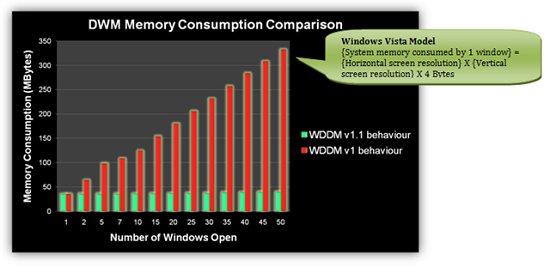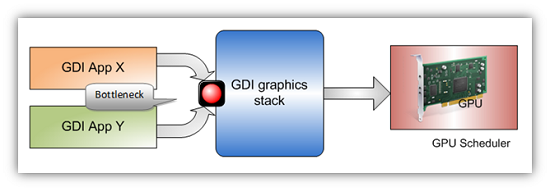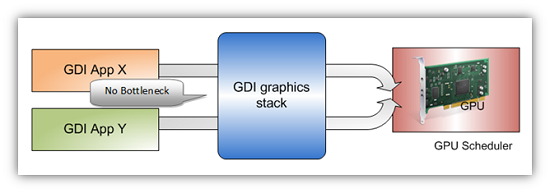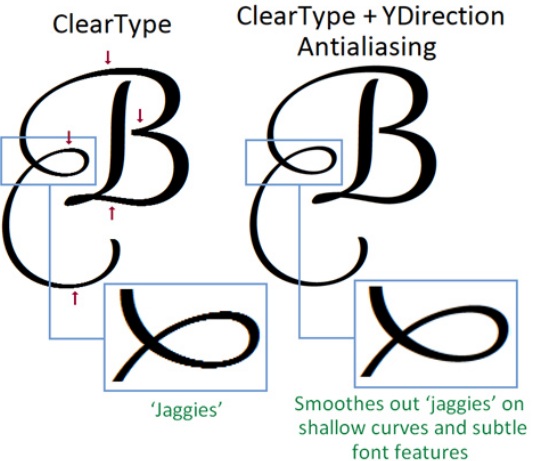Windows 7: Release Candidate 1 Preview
by Ryan Smith and Gary Key on May 5, 2009 11:00 PM EST- Posted in
- Systems
Getting Dirtier: Graphics
With the majority of the under the hood work focusing on graphics, there’s a lot to cover, so let’s get started.
Although it is being released for Vista too, Windows 7 marks the official introduction of Direct3D 11. As a superset of Direct3D 10.1, Direct3D 11 adds support for tessellation, multi-threaded rendering, and GPGPU abilities via the Compute Shader. We’ve already covered a great deal on Direct3D 11, so please see our introduction article on it for more details.
Next up we have the Windows Display Driver Model 1.1, which in turn is the lynchpin for several other graphics related features. WDDM 1.1 itself is not particularly impressive, but it’s what it allows that is. For all practical purposes, all we need to know about WDDM 1.1 is that it’s a minor revision of WDDM that requires DX10-class hardware (rather than DX9-class on WDDM 1.0) and as such allows the operating system additional features.
So what can you do with WDDM 1.1? For starters, you can significantly curtail memory usage for the Desktop Window Manager when it’s enabled for Aero. With the DWM enabled, every window is an uncompressed texture in order for it to be processed by the video card. The problem with this is that when it comes to windows drawn with Microsoft’s older GDI/GDI+ technology, the DWM needs two copies of the data – one on the video card for rendering purposes, and another copy in main memory for the DWM to work on. Because these textures are uncompressed, the amount of memory a single window takes is the product of its size, specifically: Width X Height x 4 bytes of color information.

Image courtesy Microsoft
Furthermore while a single window may not be too bad, additional windows compound this problem. In this case Microsoft lists the memory consumption of 15 1600x1200 windows at 109MB. This isn’t a problem for the video card, which has plenty of memory dedicated for the task, but for system memory it’s another issue since it’s eating into memory that could be used for something else. With WDDM 1.1, Microsoft has been able remove the copy of the texture from system memory and operate solely on the contents in video memory. As a result the memory consumption of Windows is immediately reduced, potentially by hundreds of megabytes.
What makes this even more interesting is how this was accomplished. With WinXP, GDI+ was partially accelerated, but this ability was lost to little fanfare when the DWM was introduced for Vista and thereby made GDI+ acceleration impossible, pushing all GDI work back to the CPU. This in turn is responsible for the need for a local copy of GDI and GDI+ windows and the increased memory usage of Vista, as reading data back from the video memory for the CPU to work on is too slow to be practical. The solution as it turns out is that by reintroducing GDI acceleration, the amount of read-backs can be minimized to the point that a local copy of the texture is no longer necessary. Now GDI isn’t completely accelerated, only the most common calls are, but this is enough that when the least common calls trigger a read-back, the performance hit is negligible.
This is one of the bigger changes in Windows to get memory consumption under control. The problem was particularly bad on netbooks and other systems with integrated graphics, as the video memory is the system memory, resulting in two copies of the texture being in the system memory (something such a machine probably has little of in the first place). The fact that this requires a DX10-class card with a WDDM 1.1 driver needs to be reinforced however – this won’t be of any help for systems with lesser GPUs, such as Atoms paired with the 945G chipset, as the GMA 950 GPU on that chipset is only DX9-class. NVIDIA, no doubt, is grinning from ear to ear on this one.
The other big trick as a result of WDDM 1.1 is that support for heterogeneous display drivers has returned. With WDDM 1.0 and its homogenous driver requirement, computers were limited to using video cards that would work with a single driver – in turn limiting a computer to video cards from a single vendor. With heterogeneous driver support, computers are once again free to use non-matching video cards, so long as they have a WDDM 1.1 driver. Besides that, this also is a boon for GPGPU use, as GPUs continue to interface with Windows via WDDM regardless of whether they’re actually displaying something or not. For example, this would allow NVIDIA to sell video cards as GPGPU processors to ATI owners, and vice versa.
WDDM 1.1 also brings a few lesser features to Windows 7. The DWM can now run in DX10 mode and new controls are introduced for aspect ratio scaling and controlling monitor modes.
Moving on from WDDM 1.1, Microsoft has also introduced some changes to GDI that do not require new display drivers. Along with requiring a local copy of window textures, the GDI stack was locked so that only a single GDI application could access it at a time. The GDI stack has been rebuilt so that the lock is more or less removed. Multiple GDI applications can now issue commands to it at the same time, and this is all pushed off to the video card to be its problem.


Images courtesy Microsoft
Unfortunately Microsoft has not provided us with any examples of this in action, so we’re not sure just what the real-world benefit is.
Next up, more DRM. Although we’re not entirely sure what has been changed, Microsoft has told us that they have made some changes with respect to DRM and GPU acceleration. Previously some applications playing DRMed content needed to switch to overlay mode to ensure the content was protected the entire way through. Likely this is a new low-level API for such functionality; Microsoft’s notes mention a standardized API for CPU to GPU encryption.
Last but not least, we have two new high-level graphics APIs in Windows 7. The first is Direct2D, the successor to GDI and a replacement for some Direct3D functionality. Like Direct3D, Direct2D is a fully hardware accelerated API, but it’s only for 2D operations. When Microsoft deprecated DirectDraw, the intention was for developers to use Direct3D for all of their 2D needs, but this never quite worked out as well as they intended. So now we have Direct2D, which gives developers a dedicated 2D API once again, along with a clear replacement for GDI.
Also introduced is an API specifically for text, DirectWrite. Where Direct2D works on 2D primitives, DirectWrite is responsible for the hardware anti-aliasing of text. NVIDIA sent us some documentation on the matter, and apparently the anti-aliasing method used (YDirection Antialiasing) can provide even better smoothing than ClearType can alone. It does not sound like any Windows components are currently using DirectWrite however.

Hardware font anti-aliasing in action. Image courtesy NVIDIA
We should note that while the “Direct” name implies these APIs are a part of DirectX, all of the material we have on the matter only mentions Windows 7. They may not be part of DirectX, in which case they would not be added to Vista as part of DirectX 11.










121 Comments
View All Comments
Lexington02 - Wednesday, May 6, 2009 - link
He is not late, he is claiming otherwise to the other people who think that Anandtech is MS loving while this dude is claiming to be Apple loving. I wonder, which is true... Apple lovers or Microsoft lovers...Lexington02 - Wednesday, May 6, 2009 - link
He is not late, he is claiming otherwise to the other people who think that Anandtech is MS loving while this dude is claiming to be Apple loving. I wonder, which is true... Apple lovers or Microsoft lovers...Ryan Smith - Thursday, May 7, 2009 - link
From my perspective, if I'm being accused of being an Apple and a Microsoft fanboy in the same article, then I must be doing something right.;-)I'll note that I have a preference for Mac OS X if given a choice, but I'm getting ahead of myself. I'll talk more about that in next week's Ubuntu article.
strikeback03 - Thursday, May 7, 2009 - link
That was my point - I have long stated that 90% of the articles here that compare something generate comments from both sides claiming bias each way. So the anti-Apple comments were late arriving compared to the anti-MS ones.Are we really going to get a Ubuntu article? Is it now on the transition to 9.04 instead of 8.04?
Ryan Smith - Thursday, May 7, 2009 - link
8.04 (because it's the LTS and most comparable to Windows/Mac OS X as such), to be followed up with 9.04.strikeback03 - Thursday, May 7, 2009 - link
Cool. 9.04 finally resolved some out-of-the-box compatibility problems my desktop has had with each release since I started (6.10)Gary Key - Thursday, May 7, 2009 - link
I am still a big fan of DR-DOS. Does that mean I am anti-MS also? :)MichaelD - Wednesday, May 6, 2009 - link
This is important for me as that's what I use for an AV/AM solution. Overall, it looks very impressive, particularly for a RC; it may just get me away from XP.masterbm - Wednesday, May 6, 2009 - link
I have been using windows 7 on my old amd socket 939 4200 4gb ram 8800gs. I started since build 7000. I started out being guy how felt that I was going to stay on vista for most of my machine I will upgrade to windows when it released. My htpc/file server at this time I plan on leaving it at vista. Due to their is no really good way to convert the .wtv format. This htpc box is automated in since it defrag it self scan it self for virus and spyware. Then It just added auto convert of the show that records. I took while to do that stuff not sure if want do every again.(also note htpc is amd 3800)The other thing I will note is that windows 7 becuase it feels snappier has made use that system more then use tofausto412 - Wednesday, May 6, 2009 - link
They need to make the defrag problem able to do more than one drive at a time...or to schedule them out.